Final Exam Review - overview of lectures PDF

| Title | Final Exam Review - overview of lectures |
|---|---|
| Course | Hematology And Body Fluids |
| Institution | Saint Louis University |
| Pages | 5 |
| File Size | 299.5 KB |
| File Type | |
| Total Downloads | 207 |
| Total Views | 358 |
Summary
Here is the review I promised. It’s a long one. Practical: Reticulocyte count slide with relative, absolute, and corrected reticulocyte count o I will give you the RBC and HCT A couple normal differentials One abnormal RBC differential One abnormal WBC differential (Nothing too outrageous, s...
Description
Here is the review I promised. It’s a long one. Practical: Reticulocyte count slide with relative, absolute, and corrected reticulocyte count o I will give you the RBC and HCT A couple normal differentials One abnormal RBC differential One abnormal WBC differential (Nothing too outrageous, slight left shift or mono patient (ATL) Pictures: Anything goes including mesothelial/lining cells and macrophages (Don’t worry I’ll take it easy on you this time. Mostly straightforward stuff. I’ll save the lymphomas and dysplastics for the future)
o o o o o o o o o
Granulocytes any stage= myelocytes Lymphocytes any stage (ATL’s, plasma cells etc) Monocytes any stage RBC any stage, any abnormality You must stage NRBCs (either nomenclature for this, metarubricyte Platelets Artifacts Anomolies (Pelger-Huet: boobie cells etc)
Written: o Microscope function o Magnification - a measure of the difference, usually an increase, between the size of an image and the size of the original object. Magnification refers to the amount or degree to which the object observed is enlarged. o Resolution - the ability of the lens to distinguish two small objects that are a specific distance apart. In practice, resolution is a measure of the degree of detail that can be seen in a sample. Resolution is distinct from magnification, which means making an object bigger, but does not imply any increase in detail. Resolving power is best when the distance between the two objects is small. The higher the resolution is, the smaller the size of the object that can be distinguished. o Numerical aperture (NA) - a number engraved on objective lenses that indicates the refractive index of the material between the slide and the outer lens and the angle of the light passing through it. In
o
general, the higher the NA, the better the light-gathering capability of the objective lens, thus yielding greater resolving power and the ability to distinguish objects in close proximity to each other. Imaging modes – in order to form an image of a specimen, the specimen must interact with something (light, electrons, x-ray, sound waves, etc.) and the observer must be able to detect the results of that interaction. In a compound microscope, a transmitted image is formed when the light source and the detector (your eye) are on the opposite sides of the specimen. The object must be translucent, so it is usually very thin. As more light can be passed through the object, this mode can be used with greater magnification. In dissection microscopes, a reflected image is formed when the light source and the detector are on the same side of the specimen. In this situation, the light bounces off of the specimen. You can image thicker, opaque objects but there is less light reflected so only the lower objectives can be used.
Technique: 1. Familiarization with the essential working parts of a compound microscope. 2. Base and Arm: In most modern binocular microscopes the base and arm are either molded into one piece or are attached solidly to one another by bolts or screws. In the older compound microscope, the arm was movable and hinged to the base by a piece called the inclination joint. This joint allowed the arm to be rocked backward and allowed for easier microscopy. However, modern inclined eyepiece design has eliminated the need for an inclination joint. 3. Mechanical stage on which the slide can be securely moved under the objectives. The X- and Y-axis knobs are used to move the specimen on the stage in a horizontal (X-axis) direction and in a vertical (Y-axis) direction. 4. The illumination system consists of the main light switch, the light source (which is controlled by the light intensity control knob), the condenser, and the iris diaphragm. The major illumination is the light source. The light source is equipped with a rheostat to regulate the intensity of the light. The condenser is located below the mechanical stage and serves to focus the light onto the specimen. The condenser may be raised or lowered by the condenser adjustment knob. Raising the condenser will increase the illumination directed to the objective and the objects will appear brighter, whereas lowering the condenser will have the reverse affect. The iris diaphragm is located in the condenser and regulates the amount of light that strikes the objects in view. The amount of light is regulated by opening and closing the iris of the diaphragm. Light regulation involves proper adjustment of light intensity control knob, condenser, and iris diaphragm while focusing on the viewed objects. 5. An adjustable revolving nosepiece or mount for the attachment of the objective lenses. 6. Coarse and fine adjustment knobs needed for adjusting the proper focus of the objective. Coarse focusing adjustment can only be used with 4x and 10x objectives. 7. Binocular body to which the eyepieces (or oculars) are attached and contains the prism septum necessary for binocular “image splitting”. (The ocular of choice for routine clinical microscopic work is the 10X). 8. Objectives fit into the revolving nosepiece and perform the initial magnification of the specimen. The conventional objectives are usually of the following magnifications: 4X (scanning), 10X (low power), 40X (high dry), and 100X (oil immersion). The low power objective has identifying small yellow bands around its base and should be used for inspection of the general appearance of the slide preparation for the assessment of the distribution of quantities and in the identification of large objects. The high dry objective has identifying small blue bands around its base and is used for closer analysis of slide preparations and greater magnification of detail. The oil immersion objective has identifying small white bands around its base and is used with an immersion medium of calculated refractive index, which is nearly the same as the lens and resolving power. (The objectives of choice for routine hematology microscopic work are 40X and 100X. A 50X oil objective is also available)
o Venipuncture o
o
Tube types and order of draw Know tube content with its mode of action Know which tubes are plasma and which are serum Blood culture (SPS) Sodium Cittrate blue top: 3.2% Na citrate. plasma, acts by the removal of calcium from the blood by precipitation or binding (chelation). This forms an insoluble calcium salt that prevents blood coagulation. All clotted blood must be rejected. Preferred for hemostasis and coag tests: PT, aPTT, fibrinogen. Underfilled tubes will yield false results, underfilled or overfilled must be rejected, can be used for Westergrin ESR. Venipuncture only. Red top: serum, no additives, clot activator which is it Gold top: serum, gel seperator Heparin green top: plasma, lithium heparin (light green) chem tests or sodium heparin (dark green) bone marrrow, acts by binding antithrombin and other inhibitors, antioag, can be used for osmo fragility test EDTA tube lavender or pink: plasma, used in most heme tests and some blood bank, CBC, ESR, HCT. Na or K, acts by removing of calcium from the blood by precipitation or binding (chelation), this process forms an insoluble calcium salt that prevents blood coagulation, does not reduce cell size, clotted tubes must be rejected, prevents artifacts must be used within 2 hours to make smear. Store 4 C for 24hr w/o inteference of results like hgb, CBC, hct, but if left at room temp RBC will swell and: HCT, MCV will inc. and MCHC, ESR will dec. all tests are prefered after 2 hours NaF grey top: sodium fluoride used for glucose testing b/c NaF inhibits glycolosis or NaKATPase or some shit like that Expect a bunch of these
NORMAL RANGES FOR ALL TESTS. Lots of ways this will be asked
o WBC Newborn 9-30 x103/mm3 6 mo. 6.0-18.0 x103/mm3 Female 4.5-11.0 x103/mm3 Male 4.5-11.0 x103/mm3 o RBC Newborn 3.90-5.90 x106/mm3 12 mo. 4.10-5.30 x106/mm3 Female 4.00-5.00 x106/mm3 Male 4.50-5.50 x106/mm3 o Hgb
Newborn 13.5-20.0 g/dL 6 mo. 11.0-14.0 g/dL Female 12.0-16.0 g/dL Male 14.0-17.4 g/dL
o Hct Newborn 42-60 % 12 mo 33-41 % Female 36-46 % Male 42-52 %
o RBC Indices
RDW 12-14.6 %
MCV 80-100 fL MCH 28-34 pg MCHC 32-36 % g/dL
o Plt 150-450 x103/mm3
o Westergren Sed Rate Female 50 years 0-30 mm/hr Male 50 years 0-20 mm/hr
o DIFFERENTIAL (Adult) Neutrophils 40-80 % Bands 0-5 % Lymphs 25-35 % Monocytes 2-10 % Eosinophils 0-5 % Basophils 0-1 % o NOTE: In children the lymphocyte population is generally higher and the neutrophils are lower
o Reticulocyte Newborn 1.8-8.0% Female 0.5-2.5 % Male 0.5-2.5% o Sickledex Negative o (Sickle cell screen)
o For each procedure, be able to identify o o o o o
Reagents, saline Basic steps Calculation Sources of error Disease correlation
o CBC o
List tests in CBC RBC, WBC, Plts, hgb, hct, MCV, MCHC, MCH, RDW, MPV. And w/ diff: wbc cell type %, RBC morphology, plt estimate
RBC x 3 =HGB+/- 1 o
HGB x 3= HCT +/- 3
Specimen requirements for CBC: lavender top EDTA Parameters affected by poor quality specimen
o o Procedural questions for each test including reagent, calculations, sources of error o Hemocytometer counts o May include erroneous procedure or body fluid counts o Sed Rate o Sickle Screening
o Match nomenclature systems for RBC maturation o List Leukocytes in order of maturation o
Hint: secondary granules first appear in the myelocyte
o Match body fluid with collection location o SUPER basic questions about bone marrow and cytospin o Describe how and why to do a cytospin (Basically what I said in class) o Define ME/MF ratio The test is 50 question: Matching, multiple choice (Warning my multiple choice can be killer) and calculations...
Similar Free PDFs

SCM 380 Final exam overview
- 8 Pages

Chem Final Exam Review
- 12 Pages

Final Exam - Review notes
- 92 Pages

Bio Final Exam Review
- 2 Pages

Final EXAM Review booklet
- 5 Pages
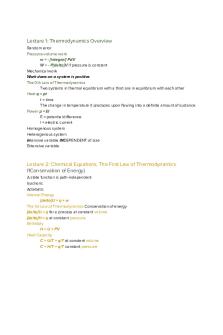
CHEM303 final exam review
- 4 Pages

Psychology Final Exam - Review
- 13 Pages
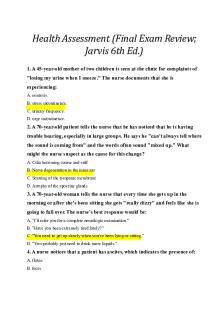
Jarvis Final Exam Review
- 12 Pages
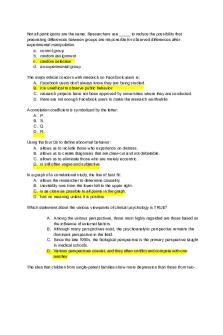
Final exam review
- 96 Pages
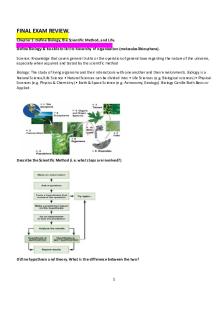
Final Exam Review
- 48 Pages
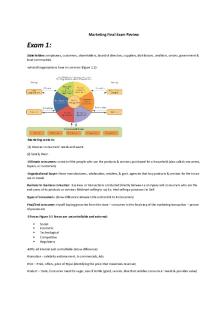
Marketing Final Exam Review
- 15 Pages
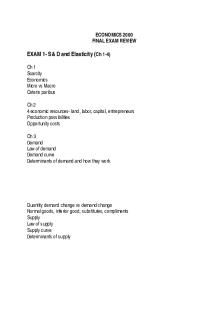
Final exam review
- 8 Pages
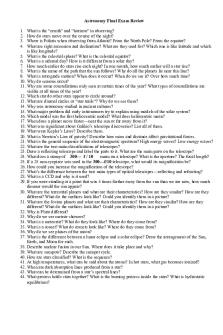
Astronomy Final Exam Review
- 2 Pages
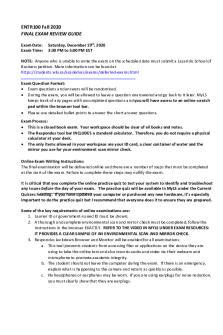
Final Exam Review Guide
- 4 Pages
Popular Institutions
- Tinajero National High School - Annex
- Politeknik Caltex Riau
- Yokohama City University
- SGT University
- University of Al-Qadisiyah
- Divine Word College of Vigan
- Techniek College Rotterdam
- Universidade de Santiago
- Universiti Teknologi MARA Cawangan Johor Kampus Pasir Gudang
- Poltekkes Kemenkes Yogyakarta
- Baguio City National High School
- Colegio san marcos
- preparatoria uno
- Centro de Bachillerato Tecnológico Industrial y de Servicios No. 107
- Dalian Maritime University
- Quang Trung Secondary School
- Colegio Tecnológico en Informática
- Corporación Regional de Educación Superior
- Grupo CEDVA
- Dar Al Uloom University
- Centro de Estudios Preuniversitarios de la Universidad Nacional de Ingeniería
- 上智大学
- Aakash International School, Nuna Majara
- San Felipe Neri Catholic School
- Kang Chiao International School - New Taipei City
- Misamis Occidental National High School
- Institución Educativa Escuela Normal Juan Ladrilleros
- Kolehiyo ng Pantukan
- Batanes State College
- Instituto Continental
- Sekolah Menengah Kejuruan Kesehatan Kaltara (Tarakan)
- Colegio de La Inmaculada Concepcion - Cebu

